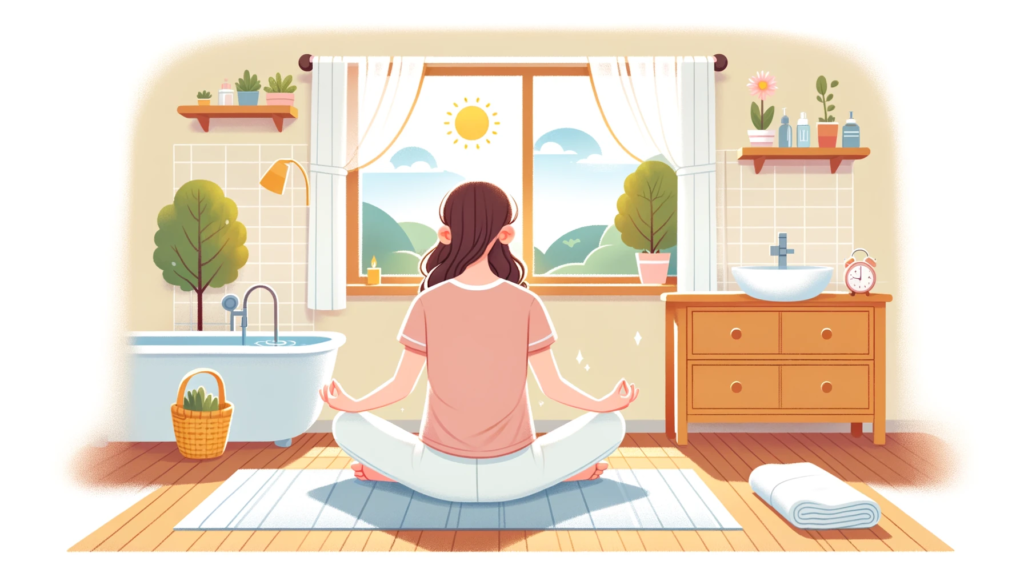
In today’s technology-driven world, digital devices have become an integral part of our daily lives.
From smartphones and tablets to laptops and televisions, we are constantly surrounded by screens.
While technology has undoubtedly made our lives easier and more convenient, it’s important to recognize the negative effects of excessive screen time on our mental and physical health.
This is where a digital detox comes into play.
In this blog, we will explore the rising need for a digital detox, the effects of excessive screen time, the concept of a digital detox, and the benefits of embracing this lifestyle change.
We will also provide a step-by-step guide to help you embark on your own digital detox journey and tips for maintaining a balanced and healthy relationship with technology.
So, if you’re ready to take a break from the digital world and prioritize your well-being, keep reading!
The Rising Need for a Digital Detox

With the increasing prevalence of technology use, there is a growing concern about its impact on our mental health and overall well-being. Many of us spend countless hours scrolling through social media feeds, endlessly checking email, or engaging in mindless browsing. This excessive screen time can lead to a variety of negative consequences, including eye strain, increased stress levels, and reduced physical activities. Recognizing the negative effects of technology addiction, more and more individuals are realizing the importance of taking a step back and embracing the concept of a digital detox.
Effects of Excessive Screen Time

Excessive screen time has been linked to a number of detrimental effects on both our physical and mental health. One of the most common consequences of excessive screen time is eye strain, which can lead to headaches, blurred vision, and dry eyes. Additionally, spending too much time on digital devices has been associated with increased stress levels, particularly among young adults. The constant stimulation and exposure to social media feeds can negatively impact our mental well-being, leading to feelings of anxiety, depression, and a decreased sense of self-worth. Furthermore, excessive screen time often replaces physical activities, which can contribute to a sedentary lifestyle and its associated health risks. It’s important for individuals of all ages to be mindful of their screen time and take proactive steps to limit their technology use.
The Concept of a Digital Detox

A digital detox refers to a period of time in which individuals consciously unplug from digital devices and limit their technology use.
The goal of a digital detox is to reduce the negative consequences of technology addiction and create a healthier, more balanced relationship with digital technology.
This can involve temporarily deactivating social media accounts, turning off notifications, or even taking a complete break from electronic devices.
It’s important to note that a digital detox looks different for everyone, and what works for one person may not work for another.
Some individuals may choose to start with small, manageable changes, while others may opt for a cold turkey approach.
The key is to find a detox strategy that works best for you and aligns with your specific goals and lifestyle.
By adopting a digital detox mindset, individuals can regain control of their technology use, reduce distractions, and create space for more fulfilling activities and connections in their daily lives.
Uncovering the Benefits of a Digital Detox

Now that we understand the rising need for a digital detox, let’s explore the numerous benefits associated with embracing this lifestyle change.
By disconnecting from technology and reducing screen time, individuals can experience enhanced focus and productivity, improved physical health, better sleep cycles, increased quality time with loved ones, and a boost in creativity.
These positive changes can have a profound impact on our mental and physical well-being, leading to a more balanced and fulfilling life.
Let’s dive deeper into each of these benefits of a digital detox.
Enhanced Focus and Productivity

In today’s digital age, it’s easy to get distracted by the constant stream of notifications, social media feeds, and online entertainment.
This constant influx of information can severely impact our ability to focus and be productive.
However, by embracing a digital detox, we can reduce distractions and create an environment that fosters enhanced focus and productivity.By consciously limiting technology use, we can develop healthier digital habits, such as setting specific time limits for social media or designating tech-free zones in our homes.
These small changes can have a big impact on our ability to concentrate on the task at hand, accomplish our goals, and make the most of our time.
Improved Physical Health

Excessive screen time has been linked to numerous physical health issues, including obesity, poor posture, and even cardiovascular problems.
By reducing our technology use and prioritizing physical activities, we can improve our physical health and combat the negative consequences of technology addiction.
Instead of spending hours in front of a screen, consider engaging in physical activities such as exercise, outdoor walks, or sports.
Regular physical activity not only improves our physical health but also enhances our mood and overall well-being.
By incorporating digital detox activities into our daily routines, we can strike a balance between technology use and physical movement, leading to a healthier and more active lifestyle.
Better Sleep Cycles

The use of electronic devices, especially before bed, can significantly disrupt our sleep cycles.
The blue light emitted by screens can suppress the production of melatonin, a hormone that regulates sleep, making it harder for us to fall asleep and stay asleep throughout the night.
By reducing screen time and establishing a digital detox routine, we can improve our sleep quality and promote better sleep cycles.
Instead of scrolling through social media feeds or watching TV in bed, consider implementing nighttime rituals that promote relaxation, such as reading a book, practicing meditation, or listening to calming music.
Additionally, removing electronic devices from the bedroom, including alarm clocks, can create a more peaceful and conducive sleep environment, allowing us to wake up feeling refreshed and rejuvenated.
Reconnecting with the Real World
One of the most significant benefits of a digital detox is the opportunity to reconnect with the real world and prioritize quality time with loved ones.
Excessive technology use often replaces face-to-face interactions, leading to a sense of disconnection and isolation.
By consciously reducing screen time, we can foster genuine connections and create meaningful experiences with the people around us.
Instead of mindlessly scrolling through social media feeds, consider picking up the phone and having a phone call with a friend or arranging a meetup in person.
By prioritizing real-world interactions, we can strengthen our relationships, enhance our social skills, and feel more fulfilled in our daily lives.
Boosting Creativity

In today’s digital world, our time is often consumed by technology, leaving little room for creative activities.
However, by embracing a digital detox, we can unlock the potential for increased creativity and innovation.
By reducing screen time, we create space in our lives for more creative pursuits.
Whether it’s painting, writing, playing an instrument, or engaging in other artistic endeavors, a digital detox allows us to tap into our creative juices and explore new passions.
Additionally, detoxing from technology can lead to positive changes in our digital habits, enabling us to use technology more intentionally and creatively, rather than relying on it as a source of constant entertainment or distraction.
By embracing a digital detox, we can enhance our creative thinking, open ourselves up to new possibilities, and experience personal growth.
Starting Your Digital Detox Journey

Now that you’re aware of the numerous benefits of a digital detox, you may be wondering how to get started.
The first step in embarking on your digital detox journey is to acknowledge the need for change and make a commitment to yourself to prioritize your well-being over excessive technology use.
It’s important to remember that a digital detox is a personal journey, and what works for someone else may not work for you.
With that in mind, let’s explore some tips to help you set realistic and achievable goals for your digital detox.
Setting Realistic Goals

When it comes to setting goals for your digital detox journey, it’s important to be realistic and specific.
Here are some tips to help you in this process:
- Assess your current technology use: Take stock of how much time you currently spend on digital devices, including social media, email, and other digital activities.
- Set specific time limits: Determine how much time you want to limit yourself to each day or week for technology use.
- Identify digital habits to change: Recognize the specific digital habits that you want to change, such as mindless scrolling, excessive social media use, or constant email checking.
- Establish boundaries: Establish specific times of the day or week when you will be tech-free, allowing yourself to fully engage in activities without distractions.
- Plan alternative activities: Identify activities that bring you joy and fulfillment, such as reading, spending time outdoors, practicing a hobby, or spending quality time with loved ones.
- By setting realistic and achievable goals, you’ll be better equipped to successfully navigate your digital detox journey and experience the positive changes that come with it.
Identifying Digital Traps

When it comes to digital detox, there are numerous digital traps that can hinder our progress.
Here are some tips to help you identify and overcome these traps:
- Recognize triggers: Identify the specific triggers or situations that lead to excessive technology use, such as boredom, stress, or loneliness.
- Remove social media apps: Consider removing social media apps from your phone or disabling notifications to reduce the temptation to constantly check your feeds.
- Be mindful of technology addiction: Acknowledge the negative consequences of technology addiction, such as decreased productivity, impaired social interactions, and increased stress levels.
- Understand the impact on mental health: Reflect on how excessive screen time affects your mental health, such as feelings of comparison, inadequacy, or FOMO (Fear of Missing Out).
- Embrace quality time away from tech: Prioritize activities that don’t involve digital devices, such as spending time with loved ones, engaging in physical activities, or pursuing hobbies.
- By being aware of the digital traps that can derail your digital detox journey, you’ll be better prepared to overcome them and stay on track towards a healthier and more balanced relationship with technology.
Step by Step Guide to a Successful Digital Detox

Embarking on a digital detox can seem daunting, but with the right approach, it can be a transformative and rewarding experience.
Here is a step-by-step guide to help you achieve a successful digital detox:
Step 1: Lock Away the Smartphone Temptation
The first step in your digital detox journey is to distance yourself from the temptation of your smartphone.
Here are some tips to help you do this:
- Put your phone on airplane mode: By switching your phone to airplane mode, you can limit distractions and reduce the temptation to constantly check for notifications.
- Designate tech-free time: Set specific time slots each day when you will be tech-free, allowing yourself to fully engage in activities without the constant distractions of your smartphone.
- Temporarily deactivate social media accounts: Consider deactivating or taking a break from social media accounts to eliminate the constant feed of updates and notifications.
- Embrace phone calls over social media feeds: Prioritize phone calls or face-to-face conversations with friends and family over scrolling through social media feeds, creating more meaningful connections and reducing screen time.
- Establish daily life habits without much technology interference: Incorporate digital detox activities, such as reading a book, going for a walk, or practicing mindfulness, into your daily routine, replacing screen time with activities that nurture your well-being.
- By taking these steps, you can reduce the temptation of your smartphone and create space in your life for more fulfilling activities and connections.
Step 2: Creating a Soothing Environment with Aroma Candles
Creating a soothing environment is essential for a successful digital detox.
Here’s how you can use aroma candles to enhance relaxation during your detox:
- Use aroma candles to create a calming ambiance: The gentle flickering of a flame and the soothing scent of a candle can help reduce stress levels and promote relaxation.
- Designate tech-free zones in your home: Create physical spaces in your home where digital devices are not allowed, such as the bedroom, dining area, or living room, allowing yourself to fully disconnect from technology during specific times of the day.
- Practice mindfulness with aromatherapy: When you light an aroma candle, take a moment to be present and fully engage in the sensory experience. Focus on the scent, the warmth of the flame, and the tranquility it brings to your space.
- Minimize technology use in specific areas of your home: Reduce the presence of digital devices, such as TVs, laptops, or tablets, in rooms where you want to create a tech-free environment, promoting relaxation and digital detox.
- By incorporating aroma candles into your digital detox routine, you can create a soothing environment that supports your relaxation and helps you disconnect from technology.
Step 3: The Power of Meditation
Meditation is a powerful tool for combating technology addiction and finding inner peace during your digital detox.
Here’s how you can incorporate meditation into your detox routine:
- Set aside dedicated time for daily meditation: Find a quiet and comfortable space where you can meditate, free from distractions. Start with just a few minutes each day and gradually increase the duration as you become more comfortable.
- Use mindfulness techniques to focus your attention: During meditation, practice mindfulness by focusing on your breath, bodily sensations, or a specific mantra. This can help quiet the mind, reduce stress levels, and increase mental clarity.
- Embrace guided meditation: If you’re new to meditation, consider using guided meditation apps or audio recordings to help you get started. These resources provide step-by-step instructions and gentle guidance, making it easier to establish a meditation practice.
- Reap the benefits of digital detox through meditation: Regular meditation can enhance your digital detox experience, allowing you to navigate technology addiction with a clear and focused mind.
- By incorporating meditation into your digital detox routine, you can cultivate mindfulness, reduce stress levels, and find inner peace in a technology-driven world.
Step 4: Sip on Some Herbal Tea for Relaxation
Incorporating herbal tea into your digital detox routine can enhance relaxation and promote overall well-being.
Here’s how you can use herbal tea to relax during your detox:
- Choose herbal teas known for their calming properties: Opt for herbal teas such as chamomile, lavender, or peppermint, which are known for their soothing and relaxing effects.
- Make herbal tea a daily ritual: Incorporate a cup of herbal tea into your daily life as part of your digital detox routine. Set aside specific times of the day, such as morning or evening, to enjoy a moment of relaxation and mindfulness.
- Use tea-drinking as a screen time break: Instead of reaching for your phone or laptop during screen time breaks, use this time to prepare and savor a cup of herbal tea. This simple act allows you to step away from technology, take a moment for yourself, and recharge from the demands of daily life.
- Experience mental and physical health benefits: Herbal tea has numerous health benefits, including improved digestion, reduced stress, and enhanced sleep quality. Incorporating herbal tea into your digital detox routine can contribute to your overall well-being.
- By embracing herbal tea as part of your digital detox, you can create a sense of relaxation, promote mindfulness, and experience the physical and mental health benefits of this simple and soothing ritual.
Step 5: Indulge in a Mindful Bathing Ritual
Indulging in a mindful bathing ritual can provide a much-needed break from technology and promote relaxation during your digital detox
.Here’s how you can incorporate a mindful bathing ritual into your detox routine:
- Create a calming environment: Dim the lights, play soft music or nature sounds, and use candles to create a tranquil atmosphere in your bathroom.
- Use natural bath products: Opt for natural bath products, such as essential oils, bath salts, or handmade soaps, that nourish your skin and engage your senses.
- Practice mindfulness in the bath: Rather than rushing through your bath, use this time to be present and fully engage in the sensory experience. Pay attention to the warmth of the water, the scent of the soap, and the feeling of relaxation washing over you.
- Detox from technology: Make the bath a tech-free zone, leaving your smartphone outside the bathroom and allowing yourself to fully disconnect and unwind.
- Experience the positive effects of digital detox: By incorporating a mindful bathing ritual into your digital detox routine, you can create a relaxing and rejuvenating experience that supports your overall well-being.
Maintaining the Digital Detox Lifestyle

Embarking on a digital detox journey is just the beginning.
To truly reap the long-term benefits, it’s important to maintain a digital detox lifestyle.
This involves finding a balance between technology use and offline activities, as well as integrating digital detox habits into your daily schedule.
By making this lifestyle change, you can continue to prioritize your mental and physical health, enhance productivity, and foster meaningful connections.
Let’s explore some tips for maintaining the digital detox lifestyle.
Finding Balance with Technology
Finding a balance between technology use and offline activities is key to maintaining a digital detox lifestyle.
Here are some tips to help you achieve this balance:
- Set daily tech boundaries: Establish specific time limits for technology use each day, allowing yourself to fully engage in activities without distractions.
- Plan tech-free activities: Incorporate activities that don’t involve digital devices into your daily schedule, such as spending time outdoors, reading, or practicing mindfulness.
- Prioritize screen-free time with loved ones: Make quality time with family and friends a priority, setting aside dedicated screen-free time where you can fully engage in conversations and activities together.
- Embrace tech-free zones: Designate specific areas of your home where technology use is not allowed, creating tech-free zones that promote relaxation, connection, and digital detox.
- Cultivate mindfulness in technology use: When you do use technology, practice mindfulness by being fully present and intentional in your interactions, avoiding mindless scrolling or excessive social media use.
- By finding a balance with technology, you can maintain a digital detox lifestyle that supports your overall well-being, productivity, and happiness.
Embracing Offline Activities
Embracing offline activities is an important part of maintaining a digital detox lifestyle.
Here are some activities to consider:
- Engage in physical activities: Incorporate regular exercise, outdoor walks, or sports into your routine to stay active and promote physical well-being.
- Read a book or write in a journal: Make time for reading or writing to relax your mind, stimulate creativity, and engage with new ideas.
- Practice mindfulness or meditation: Set aside dedicated time each day for mindfulness or meditation, helping you to stay present, reduce stress, and enhance mental clarity.
- Spend time with loved ones: Foster deep connections by spending quality time with family and friends, engaging in meaningful conversations or activities, and embracing the joy of social networking in person.
- Take a break from social media: Prioritize real-world interactions over digital connections, allowing yourself to truly be present and immerse yourself in face-to-face conversations and activities.
- By embracing offline activities, you can reduce your reliance on technology, cultivate a healthier relationship with digital devices, and truly enjoy the beauty of the real world around you.
Overcoming the Challenges of Digital Detox

While the benefits of digital detox are undeniable, overcoming the challenges of a technology addiction can be challenging.
However, with the right mindset and strategies, it is possible to navigate these challenges successfully.
Let’s explore some tips for overcoming the challenges of digital detox and making this lifestyle change a regular part of our lives.
Can a Digital Detox Become a Regular Part of Our Lives?
Yes, a digital detox can become a regular part of our lives, bringing about positive changes in our daily routines and overall well-being.
Here’s how:
- Implement digital detox as a regular practice: Rather than considering digital detox as a one-time event, aim to make it a regular part of your life. Dedicate specific times each week or month to disconnecting from technology and focusing on activities that nurture your well-being.
- Make digital detox a priority in your daily schedule: Just like you plan your meals, workouts, or social activities, incorporate digital detox into your daily schedule. Set aside dedicated time for tech-free activities, mindfulness, physical exercise, and quality time with loved ones.
- Set reminders and timers: Use technology to your advantage by setting reminders or timers to encourage you to take regular breaks from digital devices. This will help you maintain healthy habits and prevent you from slipping back into excessive screen time.
- Track your progress: Keep a journal or use apps that allow you to track your digital detox journey, noting any positive changes in your mood, productivity, sleep quality, or relationships. This will inspire you to continue embracing digital detox as a regular part of your life.
- Seek support from others: Share your digital detox goals with friends, family, or like-minded individuals who can provide support, encouragement, and accountability. Joining online or offline communities focused on digital detox can also be beneficial in staying motivated on your journey.
- By making digital detox a regular part of your life, you can experience lasting positive changes in your daily routines, mental health, physical well-being, and overall quality of life.
Conclusion

In conclusion, a digital detox can significantly improve your overall well-being by helping you regain control over your digital habits and reconnecting with the real world.
By setting realistic goals, identifying digital traps, and following a step-by-step guide, you can successfully embark on a digital detox journey.
The benefits of a digital detox include enhanced focus and productivity, improved physical health, better sleep cycles, and increased creativity.
Maintaining a digital detox lifestyle involves finding balance with technology and embracing offline activities.
While overcoming the challenges of a digital detox may be difficult, it is possible to make it a regular part of our lives with conscious effort and self-discipline.
So why not start your digital detox today and experience the positive impact it can have on your overall well-being?






